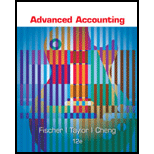
Business combination:
Business combination refers to the combining of one or more business organizations in a single entity. The business combination leads to the formation of combined financial statements. After business combination, the entities having separate control merges into one having control over all the assets and liabilities. Merging and acquisition are types of business combinations.
Consolidated financial statements:
The consolidated financial statements refer to the combined financial statements of the entities which are prepared at the year-end. The consolidated financial statements are prepared when one organization is either acquired by the other entity or two organizations merged to form the new entity. The consolidated financial statements serve the purpose of both the entities about financial information.
Value analysis:
The value analysis in a business combination is an essential part of determining the worth of the acquired entity. The
:
Prepare the value analysis and the determination and distribution of excess schedule for the investment in Company S.
Want to see the full answer?
Check out a sample textbook solution
Chapter 4 Solutions
Advanced Accounting
- Can you explain the process for solving this financial accounting problem using valid standards?arrow_forwardPQJ Company uses a job order costing system and has set a pre-determined overhead rate of 430% of direct labor cost. Job T-350 was charged with direct materials of $68,000 and with overhead of $77,400. Assume PQJ Company prices its jobs at 70% above manufacturing cost. Calculate the price charged to the customer for Job T-350.arrow_forward5 POINTarrow_forward
- I need help with this general accounting question using the proper accounting approach.arrow_forwardI need help with this general accounting question using the proper accounting approach.arrow_forwardPlease given correct answer for General accounting question I need step by step explanationarrow_forward
- Felix Manufacturing, a producer of electronic components, purchases semiconductor materials on credit on March 5. It processes these materials to make circuit boards on March 12 and pays cash for the semiconductor materials on March 20. On April 8, it sells the circuit boards to an electronics retailer, and on April 25, it receives a cash payment for this sale. What is the length of the cash cycle in this case?arrow_forwardI want to this question answer for General accounting question not need ai solutionarrow_forwardCan you explain the correct methodology to solve this general accounting problem?arrow_forward
- Upon completing an aging analysis of accounts receivable, the accountant for Riverside Manufacturing estimated that $8,600 of the $124,000 accounts receivable balance would be uncollectible. The allowance for doubtful accounts had a $740 debit balance at year-end prior to adjustment. How much is the bad debt expense? a. $740 b.$7,860 c. $9,340 d. $8,600arrow_forwardI need help finding the accurate solution to this general accounting problem with valid methods.arrow_forwardCan you explain the correct approach to solve this general accounting question?arrow_forward

 AccountingAccountingISBN:9781337272094Author:WARREN, Carl S., Reeve, James M., Duchac, Jonathan E.Publisher:Cengage Learning,
AccountingAccountingISBN:9781337272094Author:WARREN, Carl S., Reeve, James M., Duchac, Jonathan E.Publisher:Cengage Learning, Accounting Information SystemsAccountingISBN:9781337619202Author:Hall, James A.Publisher:Cengage Learning,
Accounting Information SystemsAccountingISBN:9781337619202Author:Hall, James A.Publisher:Cengage Learning, Horngren's Cost Accounting: A Managerial Emphasis...AccountingISBN:9780134475585Author:Srikant M. Datar, Madhav V. RajanPublisher:PEARSON
Horngren's Cost Accounting: A Managerial Emphasis...AccountingISBN:9780134475585Author:Srikant M. Datar, Madhav V. RajanPublisher:PEARSON Intermediate AccountingAccountingISBN:9781259722660Author:J. David Spiceland, Mark W. Nelson, Wayne M ThomasPublisher:McGraw-Hill Education
Intermediate AccountingAccountingISBN:9781259722660Author:J. David Spiceland, Mark W. Nelson, Wayne M ThomasPublisher:McGraw-Hill Education Financial and Managerial AccountingAccountingISBN:9781259726705Author:John J Wild, Ken W. Shaw, Barbara Chiappetta Fundamental Accounting PrinciplesPublisher:McGraw-Hill Education
Financial and Managerial AccountingAccountingISBN:9781259726705Author:John J Wild, Ken W. Shaw, Barbara Chiappetta Fundamental Accounting PrinciplesPublisher:McGraw-Hill Education





